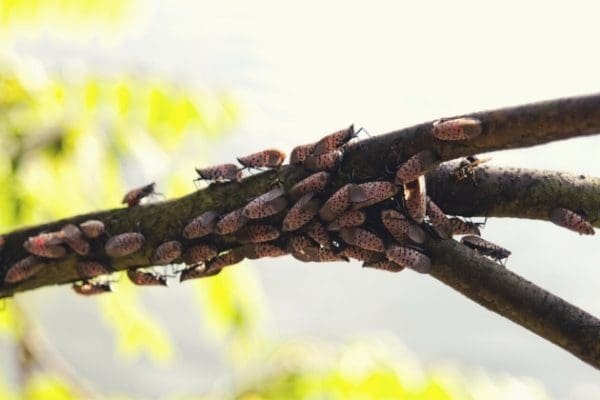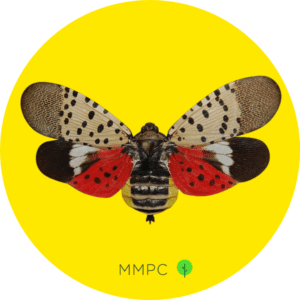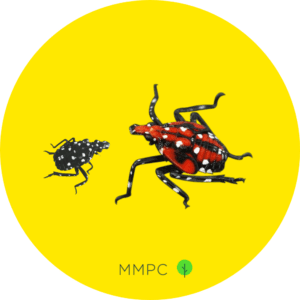
Spotted lanternflies first made their way to New York in August 2020. Since then, sightings of these pests have been reported across all five boroughs of NYC.
The spotted lanternfly (Lycorma delicatula) is a seriously invasive species of polka-dotted insects from Asia that, in 2014, was inadvertently imported into the United States on a shipment of cut stone slabs.
Infestations began to appear in Pennsylvania and quickly spread to neighboring states along the east coast, devastating crops and invading residential neighborhoods.
In this article, we’ll talk about what spotted lanternflies are and what New Yorkers can do to help get rid of them.
What Are Spotted Lanternflies?
Spotted lanternflies are an invasive species of treehoppers that have spread across the eastern United States. They primarily feed on the sap of Ailanthus altissima (tree of heaven), but they also pose a major agricultural threat to vineyards and other cultivated plants and trees.
If you haven’t seen one before, adult spotted lanternflies are about an inch long and somewhat resemble moths. When they’re resting, you’ll see two large, grayish-brown forewings with black polka dots and dark, brick-patterned tips.
Underneath these forewings, they have another pair of bright red hind wings with more black polka dots, a white stripe near the middle, and a solid black tip.
Before they reach adulthood, spotted lanternflies are typically harder to find and identify. They go through four nymph stages; in the first three stages they appear as small, black-colored insects with white dots, and in the fourth stage they appear red with white dots and black stripes.


Should You Be Concerned?
While spotted lanternflies are not directly harmful or dangerous to humans, you should be very concerned if you see them.
Once they become established in an area, spotted lanternflies spread quickly and are difficult to control. In the summer and fall, these pests can be found in huge swarms around trees, poles, sidewalks, houses, and buildings.
Getting rid of them requires cooperation of everyone. If you find spotted lanternflies around your home or neighborhood, the official instructions are to kill them immediately in order to help stop them from spreading.
Local residents should also report new sightings so that early action can be taken to prevent or slow down a potential infestation.
In New York City, since the spread of spotted lanternflies has already been confirmed in all five boroughs, the New York State Department of Agriculture and Markets (AGM) has announced that it is no longer necessary for residents to continue reporting sightings.
But if you see a spotted lanternfly outside of New York City, you should report the sighting here.

How to Get Rid of Spotted Lanternflies
While some pesticides have been effective at killing them in large numbers, spraying can sometimes do more harm than good by hurting beneficial insects and plants.
If you’re dealing with large swarms of these insects, call a licensed pest professional to safely apply EPA-registered pesticides.
For folks without a pesticide applicator license, here are 5 safe and environmentally-friendly ways to get rid of spotted lanternflies in your area.
1. Stomp Them
When you see a lone spotted lanternfly, the recommended course of action is to stomp it to death. Spotted lanternflies are not strong flyers, making them easy targets to step on.
According to the official instructions from AGM: “If you see a Spotted Lanternfly in New York City, kill it immediately by stepping on it or crushing it.”
If you miss the first time, just try again. Even though they’re quick, they can’t jump far and will quickly run out of energy, so it usually doesn’t take more than 2 or 3 tries to secure the kill.
If you see one on a tree or wall, you can swat it onto the ground before stomping it.
2. Spray Them with Insecticidal Soap
In some cases, spraying may be appropriate for getting rid of large clusters of spotted lanternflies.
Certain pesticide sprays are approved for use against spotted lanternflies, but only when product label instructions are strictly followed—these options are best left to professionals.
A good alternative to chemical sprays are insecticidal soaps and other organic insecticides, which are less toxic and safer for the environment. Examples of insecticidal soaps effective against spotted lanternflies include:
- Concern Insect Killing Soap C
- Ortho Elementals Insecticidal Soap
- Safer Insect-Killing-Soap
Try to avoid homemade sprays consisting of household items like dish soap, vinegar, rubbing alcohol, etc.
While some of these DIY recipes might seem effective at killing spotted lanternflies, they may cause also unintentional harm to nearby plants, pollinators, pets, and even humans.
3. Catch Them in an Empty Bottle
If you’re squeamish about squishing these bugs, this method might be for you. All you need is an empty plastic water bottle.
Point the opening of your bottle towards the spotted lanternfly’s head, ideally from the direction that it’s facing, and slowly approach it from above. Once you get close, the spotted lanternfly will get startled and automatically jump inside.
That’s because jumping is their natural response to being threatened, and by placing an empty bottle over a spotted lanternfly, the only way for it to jump is straight into your bottle.
Here’s a video of this in action: Viral Water Bottle Hack for Trapping Spotted Lanternfly

Using this method, you can capture a large number of spotted lanternflies with a single bottle. When you’re done, euthanize them by sticking your capped bottle into a freezer overnight.
4. Set Traps
The most common traps used for getting rid of spotted lanternflies are sticky band traps placed around tree trunks.
These take advantage of the way spotted lanternflies tend to climb up and down trees. As they climb over the sticky band, they get stuck to the strong adhesive surface.

Wrap the band around tree trunks (with the sticky side facing out) approximately 4 feet from the ground, and secure it tightly using rubber bands, staples, or push pins.
Tape over any gaps between the band and the tree bark to prevent any lanternflies from crawling past underneath.
Lastly, install a wire cage or netting around the band to avoid accidentally trapping other birds or other animals.
Sticky bands for spotted lanternflies can be purchased in gardening stores or online. You can also make your own version by using inside-out duct tape or plastic sheets covered with gum resins or petroleum jelly.
Circle traps are another kind of trap for spotted lanternflies that can be made at home with relatively common and easy-to-find materials.
This type of trap consists of insect screening mesh or plastic wrapped around tree trunks, designed to funnel any spotted lanternflies trying to climb their way up into a removable collection container.

You can learn more about circle traps and how to make them here.
As a note, traps should only be used on trees where you find spotted lanternflies, such as the tree of heaven (Ailanthus altissima), maple, black walnut, birch, and willow.
5. Search and Destroy Their Eggs
Spotted lanternflies typically lay their eggs from September through late November or early December. Gravid females typically lay 1 or 2 egg masses containing approximately 30–50 eggs each, which survive the winter and hatch in May.
Each egg is only about 1 millimeter in diameter (about the size of a grain of sand).
The eggs are laid in clusters containing several orderly rows and covered with a thick white secretion that dries into a hard, protective layer.
These egg masses are usually about 1.5 inches along and resemble dried patches of mud, ranging in color from white to dark grey or a dull brown.

The best way to destroy spotted lanternfly eggs is to scrape them off with a plastic card or putty knife, then either squash the eggs or drop them into a container of rubbing alcohol or hand sanitizer.
Here’s a video from Penn State Extension demonstrating how to properly remove spotted lanternfly eggs.
In the fall, these egg masses can be found on virtually any smooth outdoor surface, including trees, walls, cars, cardboard boxes, and other items. If you don’t destroy them, they’re likely going to be back in greater numbers next year.
Other Ways to Get Rid of Spotted Lanternflies
The methods listed above are what we, as an eco-friendly pest control company, recommend to New York City residents who come across spotted lanternflies. We based our recommendations on the effectiveness, accessibility, and eco-friendliness of the approach.
There are other methods as well—some require commercial-grade equipment, special training, or certifications, while others are untested or not environmentally safe.
If you’re exploring other options to help eliminate spotted lanternflies in your area, do your research carefully to avoid accidentally harming yourself, other wildlife, or plants.


